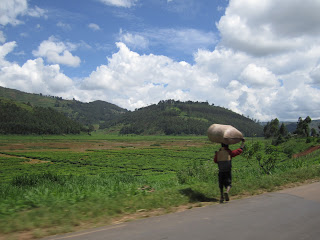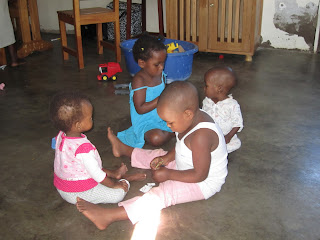Even though I have visited the Kibaale Centre on several different occasions, it wasn’t until this last week that we have gotten the chance to actually spend a few nights there and experience the place for what it really is. As Christmas is approaching (hard to believe with all the sunshine we’re getting over there in Africa), the centre has begun to give out the yearly gifts that are handed out during this season, so we all headed over there to help the KCF office and their workers with the gifts. Our duties were to hand make, organize and pass out the gifts to all of the students at the school who were designated them. The week was incredible; we not only got the chance to see the centre from a different point of view but we also got the opportunity to really experience this place and what I would consider to be the ‘real’ Africa.
Though we had expected total pandemonium, the first few days there weren’t as busy as what we had originally imagined them to be. There had been some changes in the schedule (as in true African spirit), and the first full day that we were at the centre we didn’t have much work to do. So instead we decided to hike up to the top of Kibaale hill, or as I like to call it, Kibaale mini mountain, because it’s definitely bigger than a hill, in humid 30 degree weather. The view was amazing, and the hike wasn’t terrible. It was amazing to get to see the centre from the sky and see how big the project really is. But my favourite part of the hike was the kids that we ran into on the way up the mountain. There is a community school at the base of the mountain, and when we started our hike they were all outside playing outside. When they saw all the muzungu coming they rushed over to where we were coming up the path. They didn’t speak much English, but it was just fun to be around all these kids who were so excited to see us there. The school was definitely within a poorer part of the community; Kibaale and the surrounding areas are extremely poor and therefore the schools there aren’t always the best. When the centre first opened many people questioned why North American people would even bother to invest their money and time in an area so devastated. It was once considered the ‘arm pit’ of Uganda, and it is believed that the first cases of AIDS began within this area. There are many very large families of multiple origins (grandparents taking care of grandchildren, uncles of nieces and nephews, and so on) or families that are run by children. This is because so much of the older generation has been eradicated by the AIDS epidemic. But because of the help that is now reaching the area, including the Kibaale Centre, the epidemic is beginning to slow down and this new generation of children are being given a new chance at life and many opportunities to succeed where they were not possible before.
Though we did not have as much gift giving to do as we thought, there was still quite a bit of work to be done. For the first couple of days we did a lot of administration work with KCF; this included helping to put together letters and Christmas crafts to be sent out to the sponsors. But how I have learned, Africa is very unpredictable and halfway through out time there the centre got an order for 300 gift baskets that had been donated to the school. This was amazing news because that way all of the children at the school (there are about 800 kids) were able to get something for Christmas. But this also meant that these baskets had to be put together; so with a lot of teamwork and sweat we managed to put together almost all of the gift baskets. Though most of our time was spent putting these baskets together, we also got to give a lot of these baskets away. It was awesome to be able to give these gifts out to families that often had nearly nothing.
While we were there, I also got the amazing opportunity to not only see my sponsor child again, but to also go to her home and meet her family. It’s hard to put into words the experience, but it took me a lot of self-control to hold my emotions back and prevent myself from crying. Nagawa (my little girl) lives over five kilometers from the school and walks this everyday by herself. She lives with her mother, siblings, cousins and aunts. Her father is not around and because of the lack of men living in the home much of the work had to be done by the women. When we arrived there they were hard at work in the garden. We met her mother and gave her the gift basket that we had put together for her. Just being there put so much into perspective. It was good for me to see what kind of place she really comes from. Her home was a small brick house, but many people lived inside of the house. They had the home and a bit of land, but they didn’t have much to live on. It’s so hard to explain what I saw that day because there are no words to describe it. I was overwhelmed by the poverty that she lives in everyday of her life. There were many children that lived there, and as of now Nagawa has been the only one who has been able to get into the school thus far (because the school is based on need, and there is an overwhelming need in this area so many people apply to get into the school but there is not a high acceptance rate because of they are not able to support all of the children that apply, and admission is given to those who are the neediest). What I saw and experienced that day I will never forget and it made me realize how much these people need help. We live in such a wealthy part of the world and there are so many people who need our help. If I can change one little girl’s world I want to be able to do that. After experiencing and seeing what I did, I only wish that I could do more.
Though there was a lot of emotion involved during this trip, there were also a lot of fun memories as well. We got to see the countryside from motorcycles that we rode to the town’s waterfall and down to the lake that borders the community. We also got to taste the local cuisine when we went out to Hadget’s restaurant for a night out on the townie. Though we had a lot of fun, everywhere we went there were reminders of what this place was really about; we experienced poverty and the effects of the AIDS epidemic everywhere we went. It was constant reminder of what I have back at home and how blessed I am to have been born into the life that I have been.
This trip into Kibaale was only a few days long, but what I saw and experience I will remember forever. This place won my heart over and has made me wonder what else I can do to help those in need. Seeing the way that KCC has conquered poverty and devastation makes me wonder if there is something more that I can be doing to help. There are so many people out there that need help around the world, and I know that I can’t help every single one of them. But by reaching out to a few of them I can help to change their lives, and potentially the future. I came here to help those in need, but I think that these people have instead taught me some lessons I will never forget.

















































